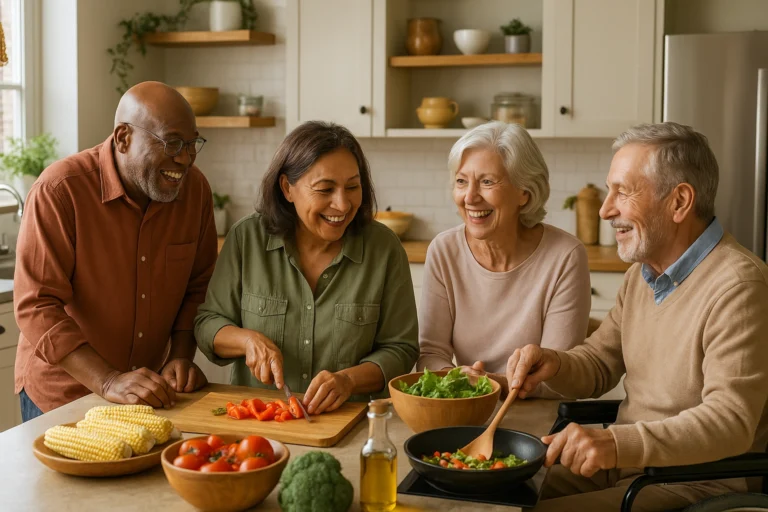Aging is an extraordinary journey, rich with experiences and wisdom that deserve to be celebrated. However, it comes with unique challenges that can sometimes overshadow the joys of living—like mobility issues, health concerns, or a heightened risk of accidents in the home. But let’s be clear: aging does not equate to frailty or vulnerability; these are simply changes we must navigate. At SeniorThrive, we’re here to champion this transition and amplify the conversations around senior safety and well-being. Our mission is to empower seniors to maintain their independence while facing these challenges head-on.
Safety strategies play an essential role in this journey because they foster autonomy and confidence as you age. Adopting proactive measures not only preserves physical health but enriches emotional well-being, ensuring that life continues unabated even in your golden years. This article dives deep into seven crucial senior safety tips—tailored for those who refuse to yield their spirit to age. We’ll explore vital adjustments both at home and within your daily routine that can safeguard not just security but also quality of life. So, whether you are a senior looking to preserve your freedom or a caregiver striving to provide support without overstepping boundaries, keep reading—there’s no need for fear when knowledge leads the way.
Senior Safety Tips: Home Modifications
As the years pass, our homes may become labyrinths of hazards. It’s crucial for seniors and their caregivers to perform a thorough assessment of living spaces to identify potential dangers. Simple things like cluttered walkways, loose rugs, and inadequate lighting can transform a once-comfortable home into a risky environment. Taking time to carefully evaluate each room can reveal hidden dangers thus, engaging in this proactive approach not only addresses existing issues but encourages awareness regarding senior safety at home.
Enhancing mobility and accessibility doesn’t have to be complex or expensive. Minor adjustments like installing grab bars in bathrooms, using non-slip mats, or rearranging furniture to create clearer pathways can significantly improve day-to-day navigation within the home. Additionally, consider leveraging technology—like adding smart home systems which offer hands-free assistance. These systems can allow seniors to control lights, locks, and alarms via voice commands or smartphone applications.
Furthermore, incorporating smart devices can augment both convenience and peace of mind. For instance, security cameras placed in strategic locations around the home provide real-time surveillance. The SeniorThrive app also plays an integral role here by connecting seniors with useful tips about health and lifestyle adjustments needed for optimal living conditions at every stage of aging. From health management reminders to emergency contacts shared across family members’ phones, embracing technology becomes an ally rather than an obstacle.
Making these essential adaptations fosters an empowering community where seniors don’t just exist—they thrive! Ultimately, assessing home environments for potential hazards and implementing thoughtful modifications lays the foundation for a safer living space that prioritizes senior health while allowing individuals to flourish as they age gracefully.
Senior Safety Tips: Health for Seniors
A balanced diet tailored to senior needs is fundamental. This means incorporating nutrient-dense foods rich in vitamins, minerals, and fiber while keeping processed sugars and saturated fats at bay. Consider adopting the Mediterranean diet, celebrated not only for its health benefits but also for its delicious flavors. Think vibrant salads packed with greens, legumes, fresh fish, and healthy oils—food that nourishes both body and spirit.
Research has shown that light resistance training can lead to substantial gains in muscle strength and bone density in seniors simply by committing to short sessions a few times a week. Physical activity holds equal importance in this equation as it strokes the flames of longevity. Engaging in regular exercise can help manage weight, improve mobility, and boost mood. Simple activities such as walking or low-impact aerobics are effective without being overwhelming. Moreover, classes that focus on strength-building or balance exercises promote stability and confidence—reducing fall risk significantly.
Equally crucial are regular health check-ups linked with effective medication management. Making appointments for comprehensive evaluations not only keeps track of vital signs but also allows healthcare providers to monitor managing chronic conditions like diabetes or heart disease closely. Staying proactive about medications is equally essential as it ensures timely refills while encouraging awareness about potential side effects. Utilizing tools like pill organizers can serve as daily prompts to keep adherence on track.
Recognizing early signs of common age-related health issues cannot be overstressed—from cognitive changes such as memory lapses to sudden shifts in physical capability. Knowledge empowers seniors along their journey: understanding what is typical versus what warrants medical attention fosters proactive responses rather than reactive measures. The key is building connections with healthcare providers where open communication reigns supreme—because embracing aging should never be an isolated affair; it’s a community endeavor where everyone plays an integral role in enhancing well-being.
Emergency Preparedness
When it comes to senior safety, having a proactive emergency preparedness plan is essential to ensuring peace of mind and stability during unexpected situations. A good starting point is creating an emergency contact list that includes family members, friends, healthcare providers, and local emergency services. This list should be easily accessible and can be kept next to your phone or saved as a note on the SeniorThrive app. By being able to reach out to trusted individuals quickly in times of need, seniors can feel more secure knowing help is just a call away.
Another critical element of emergency preparedness is assembling a disaster kit filled with essential supplies for various emergencies—whether natural disasters like hurricanes or localized crises like blackouts. This kit should include items such as non-perishable food, bottled water, medications, first-aid supplies, flashlight batteries, and even important documents like identification and health insurance information stored in waterproof containers. Tailoring these kits based on personal medical needs ensures everyone has what they require to navigate unforeseen events more comfortably.
Moreover, developing a detailed evacuation or emergency plan tailored to individual circumstances will take you one step further toward ensuring safety during crises. This involves setting specific meeting points if evacuation becomes necessary so that loved ones know where to find each other amidst chaos. Additionally, practicing this plan regularly helps solidify its importance and prepares everyone involved for quick implementation when it counts the most. Whether it’s mastering how to maneuver in areas that might become obstructed or simply feeling comfortable enough communicating with family members about preferences—preparation leads not only to safety but significantly contributes to overall senior health by reducing anxiety during emergencies.
Emergency preparedness isn’t just about having the right tools; it’s about crafting frameworks of security that empower our older adults amidst challenges while maintaining their independence as they age gracefully. Embracing this proactive mindset enables seniors—and those who care for them—to handle whatever life throws their way confidently! To learn more about effective strategies and resources available through our community at SeniorThrive, check out our extensive blog posts or visit our home page for further assistance.
Senior Safety Tips: Fall Prevention
Identifying and mitigating fall risks within the home environment is the first step to preserving your independence and ensuring safety. Common hazards like loose rugs, cluttered pathways, and poor lighting often go unnoticed. Conducting a thorough assessment of living spaces can make all the difference. Consider placing non-slip mats in high-traffic areas or removing any unnecessary furniture that could obstruct movement.
Integrating balance exercises into your daily routine is essential for strengthening muscles and improving stability. Simple activities such as tai chi or yoga are not only effective but enjoyable ways to enhance your physical capabilities. Regularly engaging in these exercises can significantly reduce the risk of falls, allowing seniors to maintain their confidence when moving around their homes.
In addition to exercise, utilizing assistive devices is a practical safety strategy that shouldn’t be overlooked. Handrails installed near stairs or in bathrooms provide crucial support while navigating potentially hazardous areas; similarly, floor mats with non-slip backing can prevent slips in slippery spots like kitchens or entryways. Taking a proactive approach by equipping your home with these resources fosters an environment where independence is preserved without compromising security. Seniors who embrace these modifications affirm their intent to live boldly: no more waiting for danger to strike—let’s take charge of our surroundings!
Ultimately, prioritizing fall prevention techniques offers peace of mind not just for seniors themselves but also for caregivers and family members who might worry about their loved one’s safety at home. By remaining vigilant and implementing smart pitfalls alongside proactive measures—even putting those balance exercises into practice—individuals can decisively contribute toward creating safe havens as well as enriched lives well into their golden years. This shift away from fear toward empowerment marks Aging 2.0—a phase filled with vibrant possibilities!
Safe Transportation Strategies
As we age, our driving abilities may naturally decline due to various factors such as vision changes, slower reaction times, or chronic health issues. It’s essential for seniors and their caregivers to have honest conversations about these changes to evaluate when it may be time to hang up the keys. This evaluation isn’t about losing independence; it’s about ensuring safety on the road—not just for the seniors themselves but for everyone sharing that space. Organizations like AARP provide resources and workshops designed specifically to help older adults assess their driving skills objectively and confidently.
When personal vehicle use becomes impractical, alternative transportation options become crucial. Many communities have developed senior-friendly transport services tailored specifically to meet the mobility needs of older adults, such as shuttle buses operated by local senior centers or volunteer-driver programs. For example, a retired nurse might join a community initiative where volunteers offer rides for grocery shopping or doctor appointments during the week, maintaining both safety and social interaction. These alternatives not only help ease the transition from independent driving but also open doors to new friendships—an invaluable aspect of healthy aging that contributes positively to overall senior health.
Moreover, staying informed about road conditions and traffic updates is vital for ensuring safe travel—even for those who still drive regularly. Apps can now provide real-time information regarding detours, construction zones, or weather-related announcements that could significantly impact travel plans. Incorporating technology into transportation strategies enhances senior safety by giving them more control over their travels while reducing anxiety around potential surprises out on the road.
Using platforms like the SeniorThrive app can effectively streamline this process by assisting loved ones in tracking ride schedules or communicating with providers when transportation assistance is needed. Implementing these strategies holds profound significance in maintaining a sense of freedom that encourages seniors to get out and enjoy life without compromising their safety—a principle at the very heart of SeniorThrive’s mission.
Digital Safety for Seniors
In today’s technology-driven world, maintaining digital safety has become as crucial as physical safety for seniors. With a growing number of scams targeting older adults, understanding how to protect personal information online is paramount. Common tactics include phishing emails disguised as trustworthy sources, lottery scams promising illegitimate winnings, or even high-pressure phone calls soliciting unexpected donations. By staying informed about these fraudulent practices and adopting a skeptical mindset, seniors can significantly reduce their risk of falling victim to cybercrime.
Implementing basic cybersecurity measures is essential in safeguarding against digital threats. Simple yet effective strategies, such as using strong passwords that combine letters, numbers, and symbols—a password manager can help with this—significantly enhance security. Regularly updating software and devices also protects against vulnerabilities that malefactors exploit. Moreover, two-factor authentication adds an extra layer of protection by requiring users to verify their identity through a secondary method before gaining access to accounts.
Encouraging tech literacy within senior communities is another pivotal step toward enhancing online safety. Many local libraries and community centers offer classes designed specifically for older adults, where they can learn not just how to navigate the internet safely but also how to harness its power for staying connected. Programs like SeniorThrive’s tech workshops give seniors the opportunity to practice safe browsing habits firsthand while building confidence in their technological abilities. Such initiatives foster a supportive environment where individuals can ask questions freely and share experiences without fear of judgment.
Ultimately, internet safety extends beyond mere precautions; it fosters empowerment among seniors who refuse to let technology pass them by unnoticed. As more aspects of life move into the digital realm—from banking services to social connections—taking charge of one’s online presence becomes an essential part of aging actively and independently. Representing a critical intersection between self-empowerment and security, mastering digital safety allows seniors not only to preserve their privacy but also enhances overall quality of life during those golden years. For additional resources on enhancing your digital literacy and safety practices, visit SeniorThrive today!
Social Engagement Opportunities
As we age, the importance of social engagement becomes increasingly clear. Maintaining connections with others not only enriches our lives but also plays a significant role in promoting senior health and well-being. Community events and clubs offer numerous opportunities for seniors to gather, share experiences, and forge lasting friendships. Whether it’s joining a book club at the local library or participating in weekly exercise classes at the community center, these gatherings help combat loneliness and keep spirits high.
The mental health benefits of staying socially active are profound. Studies indicate that regular interactions can reduce feelings of depression and anxiety while enhancing overall cognitive function. For instance, participating actively in a gardening group not only fosters camaraderie but also gets you physically moving—digging, planting, and enjoying the fruits (and vegetables) of your labor together.
Exploring volunteer opportunities is another powerful way to stay connected. Many non-profit organizations welcome seniors who wish to contribute their time and skills for meaningful causes. Whether helping out at a pet rescue organization or mentoring young students through local schools, volunteering aligns with personal interests while providing a sense of purpose. This avenue not only energizes the soul but keeps one engaged within their community.
To further facilitate social engagement, consider leveraging modern technology that connects seniors with nearby events based on their interests. By embracing both traditional and digital platforms for interaction, older adults can create vibrant networks—enhancing not just senior safety but also joy throughout the aging journey.
Empowering Your Golden Years
As we’ve highlighted in this article, navigating through the golden years of life doesn’t have to be fraught with challenges. By implementing crucial senior safety tips—from making your home safer and healthier to ensuring social engagement and digital security—you’re not just enhancing your well-being; you’re affirming your right to age on your terms. Each step you take towards creating a secure environment fosters independence and confidence, and ultimately, paves the way for a vibrant life filled with new possibilities.
We encourage seniors, families, and caregivers alike to embrace these practices wholeheartedly. They are not just recommendations but rather essential strategies that empower older adults to thrive rather than merely survive. The journey of aging is one worthy of celebration—so let’s uphold that spirit! For additional resources tailored specifically for seniors in their pursuit of safety and health, we invite you to explore the SeniorThrive App. Together, we can rewrite what it means to age—stronger, bolder, and better in every aspect of life.



